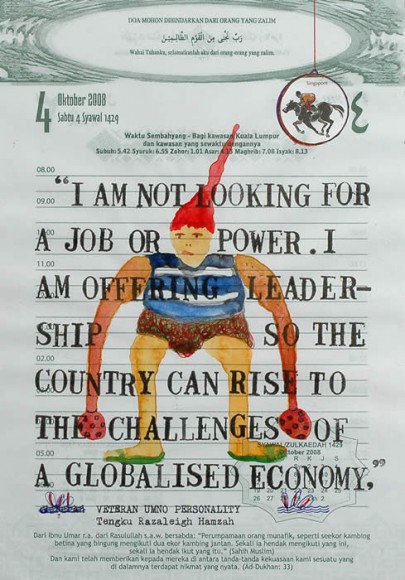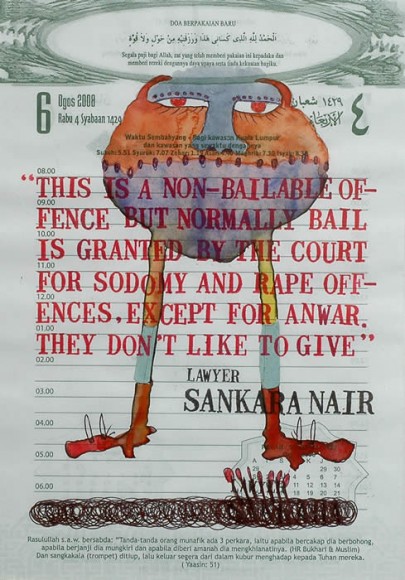


Nor Azizan Rahman Paiman: Malaysia-365 days of 2008
Wei-Ling Gallery
11 May – 29 May 2009
Paiman’s Malaysia – 365 days of 2008 reminded me of two things. More apparent is the similar exercise of highlighting quotes by prominent figures in the Malaysian political landscape found in Amir Muhammad’s Politicians Say The Darndest Things series. Less obvious is a meditative methodology of approaching drawing as a daily assignment I remember from Kamin Lertchaiprasert’s Sitting series, a now common language in contemporary art that has achieved varying degrees of succcess.
Unlike Amir’s fallback on irony and Kamin’s reliance on spiritual transcendentalism, Paiman’s calendrical portrait of Malaysia is weighed by the political reality that have shaped how we, who are living in Malaysia, come to understand 2008. As a stretch of time in which we witness the country’s democratic struggle achieved some promising result, we also witnessed the political debacles that ensued from what appears to be, at times and for the first time in many years, episodes of compellingly liberating political contestation.

Paiman’s drawing installation begins with the discipline of a daily exercise, routinely selecting a verbatim from a published mainstream media source that would best represent the political development of the day. He then types them on the entry page of the appropriate date from an Islamic diary and pairs them with a doodle of his mutant comic figures that are largely devoid of any political commentary.
Each page then reads on three different registers. There’s the Islamic prayer that heads and ends each page, framing the day with an invocation requesting for the removal of all the obstacles we may face as well as a excerpted homily from one of the Prophet Muhammad’s disciples.
Then there’s the chosen quote and the illustration. Factoring all these things on a piece of paper create a concentrated visual and information field where different signifiers compete for attention and different readings. This confluence is perhaps the strongest aspect of the show and introduces a layered response to the temporal development of Malaysian politics without the need to resort to didacticism.

What appears to be the exhibition main weakness is the installation of the show as a whole. The layout is confusing and the arrangement of works, though chronological, failed to suggest a temporal passage through which we can engage with a linear history. This setback is however redeemed by the questions that the individual works raised.
One is drawn to question about the nature of the illustrations themselves. Are they a creative act of experimentation that develop in tandem with the social history of a country? Are they autonomous from context? Are their non-commitment to address directly social issues a form of self-censorship? What is the relationship between the text and the image, when they diverge at the point in which meaning and non-meaning is communicated?
A practice that is based on daily examination is in many ways a contemplative process. It’s interesting to see how Paiman’s choice of an Islamic diary as a foundational structure for this series suggests at the socio-cultural implication of recognising Islam as the country’s official religion. Is this an inescapable and inevitable framework from which our discourses must ultimately reflect? Given that Malaysia is still by and large a multi-cultural country, in what capacity does Islam play, as an official religion, in the course of constructing multi-ethnic multi-religious identity as a nation?
These questions though not resolved are underscored in the tension where these contradictory registers co-exist on a single sheet of paper, suggesting perhaps that all creative act must to some extent address our present day conundrum. Is this true?

(SS)
Sorry, the comment form is closed at this time.
I like the show a lot. The works look a little stuffy behind those silver frames. But they are cute drawings, especially those with race horses pasted onto them.
Actually, a very very clever work of art. Great documentation record, thru the arts, of a relevant year.This is significant in itself. The continous reading of the quotes, from members of the public present, emphasised the relevance of the work and the enjoyment it brought.The hanging was fine and yes ,Malaysia is an Islamic country.And yes Malaysia also recognises the Christians and the Buddhists and the Hindus and any and all religions respectfully.
Hi Alienfriend and Farouk,
Thanks for the response.
I like it because it’s not only a great documentation, it also creatively response to this history of ours and brings in a whole set of questions about how art can be practiced in our society and the implications of a nation’s socio-cultural history on creativity.
I would have like to ask Paiman though why he has only stuck to textual materials from mainstream print media and not alternative media too (such as Malaysiakini or other blogs) given that it is often said that a big part of the electoral shift owed a great deal to the greater visibility and accessibility of alternative viewpoints in this country.
-simon
I’ve always been a fan of Paiman’s work, and was looking forward to this show. Sad i didn’t get to catch it.
I saw peeps from Balai in the Whose Who? Wonder if they will acquire (have acquired?) the whole set. They should.
I think the strength of the work lies in its quiet contemplation. Three things are coming together – public life (the quotes), artistic impulse (drawings) and the personal (the diary).
I like how they operate very differently from Amir Muhammad’s Politicians Say the Darnest Things books – which are more naughty and bitey. Would’ve been interesting to have the book sold alongside. In fact, would love to see the series published as a book.
Wish the works weren’t framed like that though.
atcually they have produced a great book of the whole series. Am impressed with how the whole show has been put together. The book is well worth getting. The book is in fact as great an attraction as the wall hanging.
Sharon says:
I think the strength of the work lies in its quiet contemplation. Three things are coming together – public life (the quotes), artistic impulse (drawings) and the personal (the diary).
Was thinking of what sharon said above, looking at ‘things’ as a single entity or as a collective. 366 drawings (for a year) is a lot to swallow in one viewing. As a viewer of the exhibition, what do we see? Some were interested with the quotes, others the funny images. While a few were looking at their own birthday!!! What I would like to suggest though, is the significance of Paiman’s viewpoint. Why the specific quote for the day? How it is incorporated with the specific image to create a wholesome image… The book, I felt, created a different feeling from the exhibition in the sense that we may compare the different days of the year more easily by flipping the pages
Malaysia is NOT an Islamic country.